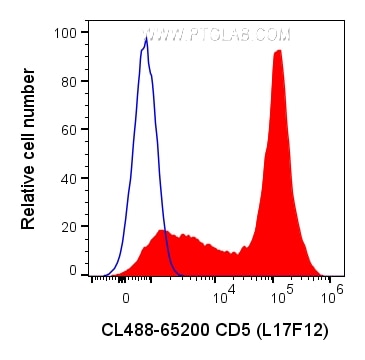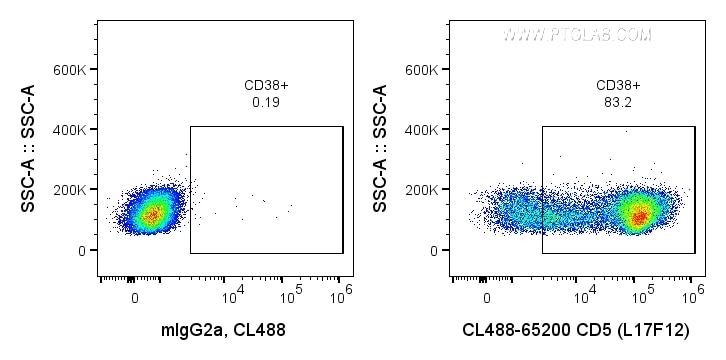Anticorps Monoclonal anti-CD5
CD5 Monoclonal Antibody for FC
Hôte / Isotype
Mouse / IgG2a, kappa
Réactivité testée
Humain
Applications
FC
Conjugaison
CoraLite® Plus 488 Fluorescent Dye
CloneNo.
L17F12
N° de cat : CL488-65200
Synonymes
Galerie de données de validation
Applications testées
| Résultats positifs en cytométrie | CMSP humaines, |
Dilution recommandée
| Application | Dilution |
|---|---|
| This reagent has been pre-titrated and tested for flow cytometric analysis. The suggested use of this reagent is 5 μl per 10^6 cells in a 100 µl suspension or 5 μl per 100 µl of whole blood. | |
| Sample-dependent, check data in validation data gallery | |
Informations sur le produit
CL488-65200 cible CD5 dans les applications de FC et montre une réactivité avec des échantillons Humain
| Réactivité | Humain |
| Hôte / Isotype | Mouse / IgG2a, kappa |
| Clonalité | Monoclonal |
| Type | Anticorps |
| Immunogène | Cellules humaines de leucémie lymphoblastique aiguë à lymphocytes T (LAL-T) |
| Nom complet | CD5 molecule |
| Masse moléculaire calculée | 495 aa, 55 kDa |
| Numéro d’acquisition GenBank | BC027901 |
| Symbole du gène | CD5 |
| Identification du gène (NCBI) | 921 |
| Conjugaison | CoraLite® Plus 488 Fluorescent Dye |
| Excitation/Emission maxima wavelengths | 493 nm / 522 nm |
| Forme | Liquide |
| Méthode de purification | Purification par protéine A |
| Tampon de stockage | PBS avec azoture de sodium à 0,1 % et BSA à 0,5 %, pH 7,3. |
| Conditions de stockage | Store at 2-8°C. Avoid exposure to light. Stable for one year after shipment. |
Informations générales
CD5 is a type I transmembrane glycoprotein of the scavenger receptor cysteine-rich family (PMID: 12403363). CD5 is expressed on a majority of thymocytes, mature T cells, B cell subsets, and peripheral blood dendritic cells (PMID: 9858516; 6156984; 10379049; 1384337). CD5 may act as a receptor in regulating T-cell proliferation. It functions as a negative regulator of TCR signaling during thymocyte development (PMID: 7542801).
Protocole
| Product Specific Protocols | |
|---|---|
| FC protocol for CL Plus 488 CD5 antibody CL488-65200 | Download protocol |
| Standard Protocols | |
|---|---|
| Click here to view our Standard Protocols |



